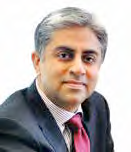
 Rising healthcare expenses, lifestyle diseases and increasing awareness among citizens have together boosted the growth of health insurance in India. The new IRDA guidelines and government schemes are catalysing the expansion. Monalisa, ENN, explores the dynamics of the evolving market.
Rising healthcare expenses, lifestyle diseases and increasing awareness among citizens have together boosted the growth of health insurance in India. The new IRDA guidelines and government schemes are catalysing the expansion. Monalisa, ENN, explores the dynamics of the evolving market.
Health Insurance is among the most rapidly evolving sectors in India, with a compounded annual growth rate of 37 percent. In the Indian non-life insurance industry, health insurance is the second largest segment after motor insurance. While the penetration of the market is currently small (10 percent of the total population in India), the World Bank has estimated it shall cover 50 percent of the population by 2015.
This growth can be attributed to the combined efforts of Health Insurance providers, Third Party Administrators (TPAs) and various government sponsored schemes such as the Rashtriya Swasthya Bima Yojana.

Market Size
The market size for health insurance for the year 2012-13 was `15,341 crore, which was about 22 percent of the overall non-life premiums. It is likely to be anywhere between 17,500 to 18,000 cores by March 2014, says Shreeraj Deshpande, Head – Health Insurance, Future Generali India Insurance Company Ltd.
According to Insurance Regulatory and Development Authority (IRDA) data, the health insurance industry expanded at a compounded annual growth rate of 33 percent from 2006- 12. Also, the total number of health insurance policy holders grew from 8.3 million in 2004 to 200 million in 2011.
Industry research and consultancy firm, RNCOS, states that health insurance premiums recorded a growth of 14.05 percent from `115 billion underwritten in 2010-11 up to `131 billion underwritten in 2011-12. The premiums are expected to increase at a CAGR of 30 percent during 2012“14, and reach up to `505 billion by 2016.
 The market is promising for industries which can devise strategies to overcome challenges of limited product range, price and awareness Shushmul Maheshwari, Chief utive, RNCOS |
Growth Triggers
Rising incomes and greater awareness have added fillip to the Indian health insurance market, providing lucrative growth avenues for both the existing players as well as new entrants. With increasing concern among middle class over lifestyle diseases and increasing government investment in the healthcare industry, the health insurance market sets out vast opportunities for companies planning to penetrate the market, says Shushmul Maheshwari, Chief utive, RNCOS. The market is promising for industries which can devise strategies to overcome challenges of limited product range, price and awareness which restrain the growth, he adds.
High healthcare costs have further accentuated the need for health insurance. Coupled with this is the emergence of multi-speciality hospital chains in metro cities, which have raised the quality and cost of healthcare, hence making health insurance the need of the times.
Meanwhile, programmes such as insurance offered by NGOs; community- based health insurance; corporate insurance policies; and government sponsored schemes have enabled low-cost health insurance facilities to the citizens.
The Rashtriya Swasthya Bima Yojana is one such initiative, points out says Pompy Sridhar, Financial Sector Development Specialist and Consultant Health Insurance. Such platforms overcome the handicap of poor rural connectivity and allows for real-time administration of health insurance schemes. They also improve dramatically the viability of the supply side by offering a sustainable business model at lower costs to the intermediary / providers of healthcare through captive volume, she adds.

Challenges
However, despite the best efforts by the regulator, the government and industry stakeholders, the health insurance sector is gripped by a couple of challenges, primary among them being high incidents of fraud claims, lack of standard practices across the industry and long turnaround times for claims settlements, hence keeping the policy holder waiting and dissatisfied. Add to this the low awareness, lack of understanding of product features and perceived apprehensions in claims procedures and settlement, which further demotivate consumers from buying a health cover.
 Quantification of benefits provided under health insurance covers and consistent service standards remain the biggest challenge and are a must to build trust in this sector, says Sridhar.
Quantification of benefits provided under health insurance covers and consistent service standards remain the biggest challenge and are a must to build trust in this sector, says Sridhar.
Also, high claims ratios and inaccurate data regarding consumer profile, disease patterns, etc often act as detrimental factors for insurers in product pricing or development of new products. Another growing concern is the rise in the demand for customised health insurance plans that most enterprises are providing to their employees. This has resulted in huge and multiple formats of data for insurers and TPAs to manage.
There is the cruicial need for data analytics to empower stakeholders through provision of accurate, timely and reliable data. Easy availability, granularity and quality of data can help in more efficient decision making and pricing strategy, says Suresh Sugathan, Head “ Health Insurance, Bajaj Allianz General Insurance.
We have developed an inhouse capability of managing varied requirements of our corporate customers on the bedrock of a robust IT framework. This facilitates a flexible benefit set-up template that allows for various combinations of benefits and Sum insured to be clubbed into a single policy, says Anuj Gulati, CEO, Religare Health Insurance Company Ltd.
 IRDAs mandate on tripartite agreement between hospitals TPAs and insurers does away with any variance and ambiguity in the role of each stakeholder Anuj Gulati, |
Policy Change
The recent IRDA guidelines are a step to address some of these challenges. With the aim of improving service standards in the health insurance sector, IRDA announced a host of new guidelines this year. First of all, it has standardised 46 most commonly used definitions/terms/conditions in health insurance policies. In order to avoid confusion and reduce turnaround time in claims settlements, the regulator has also standardised pre-authorisation and claims forms to streamline processes at all stages.
Most insurers have welcomed these pro-customer initiatives. There are around 400 health insurance products available in India with various insurance companies. It is indeed difficult for the customer to choose the best plan for himself when every cover is defined differently, says S S Gopalarathnam, Managing Director, Cholamandalam MS General Insurance Company Ltd. The new IRDA health insurance regulations will not only help in bringing a lot of transparency to the customers but also make it easier for customers to compare various benefits/coverage of different health insurance products available across the companies, he adds.
Agrees Sugathan: Standardisation of medical terms, procedures, claim forms, exclusions and agreements, etc will reduce ambiguity which existed in the market due to variable interpretation of key policy terms.
Interestingly, the new policies have redefined the role of TPAs as well. IRDA has mentioned that hospitals, insurers and TPAs will now have a tripartite agreement instead of the conventional bilateral agreement between TPAs and hospitals. This encourages transparency between the stakeholders and also places ownership of the transaction with the Insurance Company, ensuring better servicing and high levels of standardization for the customer, says Gulati. The tripartite agreement between the Insurer, TPA and the Hospital makes the Insurer the owner of the Network and ensures standardisation of services levels to the customer, adds Gulati.
 Quantification of benefits provided under health insurance covers and consistent service standards remain the biggest challenge and are a must to build trust in this sector. Pompy Sridhar, |
Future Trends
With collective efforts by all stakeholders, the future seems bright for the industry. The gap between healthcare expenditure and that covered by health insurance in India is huge, up to USD 57 billion. This is projected to exceed up to USD 200 billion by 2020, which presents a huge opportunity for health insurance to emerge as a viable financing mechanism for growing healthcare spend.
The health insurance sector in the country will continue to grow between 15-20 percent for the next five years. The focus will have to be on how the retail segment can grow much faster and how group health, which at present is a loss-making business for the insurers, starts turning around, says Deshpande.
Market players foresee the emergence of OPD insurance in a big way, apart from the rise of disease and case management for patients. Sixty percent of healthcare spend in India is now in OPD and most of it is out-ofthe- pocket. So we are looking at how we can cover that aspect of business and have started offering it as an addon with some of our products, says Sanjay Datta, Chief “ Underwriting and Claims, ICICI Lombard. Globally the trend is to offer OPD with hospital coverage so we may see similar offerings in India soon, he adds. Conditions that are rare, cosmetic surgery, congeniality diseases, infertility are not covered in India. Going ahead, these might evolve as separate products going further. Even AIDS has the possibility of coverage in future. Some of the emerging trends to arise include: programmes to predict, detect and address medical problems; diseasespecific products; employee sponsored wellness activities; empanelment of specialist physicians; HIS and Patient Health Records, says Sugathan.
Be a part of Elets Collaborative Initiatives. Join Us for Upcoming Events and explore business opportunities. Like us on Facebook , connect with us on LinkedIn and follow us on Twitter , Instagram.












